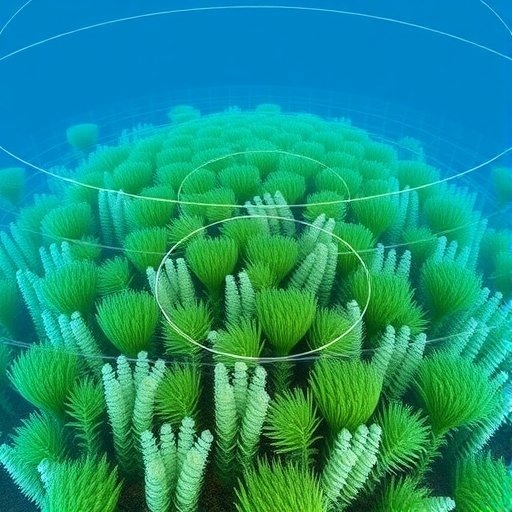In a groundbreaking study published in Coral Reefs, researchers have developed a sophisticated spatial numerical model aimed at unraveling the complex interactions between seagrass ecosystems and herbivorous fish. This innovative approach provides a fresh perspective on the dynamics of marine biodiversity, particularly focusing on how these interactions contribute to the formation of reef halos—distinctive areas characterized by the lush growth of seagrass and the grazing activities of herbivores. As marine environments face increased threats from climate change and human activity, understanding these relationships becomes paramount for conservation efforts.
Marine ecosystems are increasingly jeopardized by anthropogenic factors, leading to habitat degradation and species decline. One of the most significant yet often overlooked components of marine biodiversity is seagrass. These underwater plants act as critical habitats and nurseries for various marine organisms, including economically important fish species. Seagrass beds also provide essential ecosystem services, such as carbon sequestration and nutrient cycling, which are vital for maintaining oceanic health. However, the interplay between seagrass and herbivores, particularly how they affect each other’s distribution and abundance, has not been fully understood.
The research team, led by Llabrés and including experts Innes-Gold and DiFiore, employed a detailed numerical modeling approach that integrates biological data, environmental variables, and ecological dynamics. Their model simulates how herbivore populations interact with seagrass ecosystems, creating a detailed representation of these interactions over time and space. This method allows researchers to visualize and understand the relationships between herbivores, such as parrotfish and sea turtles, and the seagrass they graze upon, providing insights that traditional field studies alone cannot offer.
A central theme of the study is the concept of “reef halos,” areas influenced significantly by herbivore grazing behavior. These halos are marked by healthy and thriving seagrass that is kept in balance through the feeding patterns of herbivorous fish. The model reveals that the density of herbivorous fish can profoundly affect the health of seagrass ecosystems, as these grazers maintain the seagrass in a state that promotes biodiversity and resilience. The research highlights the necessity of managing herbivore populations to support the stability of seagrass beds, ultimately benefitting the wider marine ecosystem.
One of the remarkable findings of this model is its ability to predict how changes in herbivore density can affect the spatial distribution of seagrass. For instance, increased herbivorous fish populations are shown to enhance seagrass growth, leading to more robust and extensive habitats that can support diverse marine life. Conversely, overfishing or declines in herbivore populations can lead to seagrass degradation, emphasizing the delicate balance that exists within these marine systems.
The implications of this research extend beyond mere academic interest. With global seagrass ecosystems facing threats from coastal development, pollution, and climate change, understanding the mechanisms behind seagrass and herbivore interactions is crucial for effective conservation strategies. The researchers argue that informed management practices must incorporate biodiversity considerations, particularly focusing on maintaining healthy herbivore populations to ensure the resilience of seagrass ecosystems against environmental pressures.
Furthermore, the study provides important guidelines for policymakers and conservationists. It advocates for the establishment of marine protected areas (MPAs) that focus specifically on areas with significant herbivore populations. By safeguarding these critical zones, it may be possible to enhance seagrass health and, consequently, the overall biodiversity of the region. The researchers call for further empirical studies to validate the model’s predictions and to understand how these dynamics may shift with ongoing climate change.
The model also opens new avenues for future research, particularly the potential for integrating climate data to predict how rising sea temperatures and ocean acidification might alter herbivore behavior and, in turn, impact seagrass health. Such investigations are essential to build a comprehensive understanding of marine ecosystems and the cascading effects of climate change on their intricate webs of life.
Another exciting application of this research lies in its potential contribution to reef restoration efforts. By highlighting the pivotal role of herbivores in maintaining seagrass health, restoration projects can prioritize the reintroduction and protection of key species that promote ecological balance. This could lead to more successful outcomes in restoring degraded ecosystems and enhancing marine biodiversity.
In conclusion, the study conducted by Llabrés and collaborators marks a significant advancement in marine ecological modeling. By providing a detailed spatial numerical model of seagrass-herbivore interactions and the formation of reef halos, the research underscores the critical need to integrate ecological dynamics into management practices. The findings emphasize that the future of seagrass ecosystems, and consequently marine biodiversity, hinges on recognizing the vital role that herbivores play in these complex systems.
As marine conservation faces myriad challenges, this research offers a beacon of hope and a roadmap for sustainable management aimed at preserving our oceans and the rich biodiversity they harbor. The outcomes of this study will undoubtedly shape future research in marine ecology and conservation, paving the way for more targeted and effective initiatives designed to protect these essential ecosystems.
Ultimately, the work of Llabrés, Innes-Gold, DiFiore, and their team demonstrates the synergy between scientific inquiry and practical conservation efforts. Through innovative research like this, the scientific community can contribute vital knowledge necessary for the stewardship of marine environments. In a rapidly changing world, insights into seagrass and herbivore dynamics will be crucial in informing our approaches to mitigate human impact and preserve the rich tapestry of life found beneath the waves.
Subject of Research: Seagrass–Herbivore Interactions and Reef Halo Formation
Article Title: A spatial numerical model for seagrass–herbivore interactions and the formation of reef halos
Article References:
Llabrés, E., Innes-Gold, A.A., DiFiore, B. et al. A spatial numerical model for seagrass–herbivore interactions and the formation of reef halos.
Coral Reefs (2025). https://doi.org/10.1007/s00338-025-02729-3
Image Credits: AI Generated
DOI: https://doi.org/10.1007/s00338-025-02729-3
Keywords: Seagrass, Herbivores, Reef Halos, Biodiversity, Marine Ecology, Conservation Strategies.




